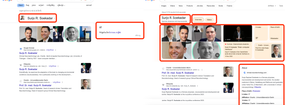
Digital Persona Coach - Kaj Kandler
Kaj Kandler coaches notable people to become visible in search engines. He provides coaching to promote their digital persona.
Personal branding in a Google first world
Exchanging business cards was yesterday. In the eyes of the people you network with, your brand is shaped by what they can "google" about you. How well are you represented in modern search engines like Google and Bing?
Search engines have gone ca. 2012 from matching strings (keywords) to matching entities (things). Search engines now understand the semantic meaning of words. They can interpret a surname and a family name and connect it to a person.
Google and other search engines create special databases of things. These databases are called Knowledge Graphs [1]. A knowledge graph consists of things. A thing in a knowledge graph can be a person, an organization, a book, a movie, an event, or a concept. Each thing is formally described by properties. Common properties are name, description, url, worksFor, knowsAbout, and many other descriptive attributes. Some of these attributes are special as they connect one thing to another. For example, "worksFor" can connect a person to an organization. Another example is knowsAbout, which connects a person to a concept.
With semantic search search engines recognize a name as a person. This only happens when the search engine has enough information about this person. More importantly, Google needs to connect the different sources of into a coherent set of data.
With all this development in search engines, it becomes vital to strategically manage and expand your digital persona [2]. You should be in control of the information that is published on the web and influence what is important and what not.
The goal - A rich Knowledge Panel and Knowledge Cards
The goal of developing a digital persona is to be found in search engines by name. Furthermore, you want the search results to show you in the best light possible.
If Google understands a persen well, it displays knowledge cards [3] and a knowledge panel [4]. It can only do this if it has collected enough information about the person. See below what difference this can make.

In technical terms, the goal is for Google to recognize your digital persona as an entity [5]. Furthermore, you want this entity to be rich in information about you. Last but not least you want Google to associate a search for your name with you as the dominant entity.
The Process - from Invisible to Dominant Entity for your Name
In my coaching, I follow a four-step process to make Google take note of a Person:
- Brand Search Visibility Audit
- Assessment of the desired visibility
- Establishment of an entity home
- Optimization of brand consistency
We monitor the process by measuring the visibility in the search results for the brand.
The coaching process requires strong participation by the subject and their technical staff. Without participation, it will not succeed. We will provide the assessments and monitoring, as well as an agreed-upon action plan. We do not provide a service to build the website or do technical SEO to the website. All online assets remain in the ownership and responsibility of the client. However, we will advise on technical questions, such as schema markup and how to implement it.
Such an action plan can consist of:
- Establishing a digital persona hub [6] or entity home
- Building Links
- Adding Schema Markup
- Optimizing Schema Markup
- Content Improvements
- Optimizing Social Media and Author Profiles
- Optimizing Text on the page(s)
- Adding pages for services, authors, etc.
- Increasing Notability
- Adding a social media presence
- Adding public images and videos
- Writing articles, books, and publishing other creative works
- Seeking interviews in the media
- Seeking press coverage
Glossary
Important terms to understand the technical aspects of personal branding in search engines
A Knowledge Graph is a graph with entities as nodes. An entity has properties that contain the information known about the entity.
The edges of the knowledge graph are built by those properties that contain a value that is another entity. ↩︎ ↩︎
A digital persona is the aspect of a personal brand that is shaped by the person's online presence, behavior, and interactions on the internet. ↩︎
Knowledge Cards display a few very well-understood properties of an entity in the knowledge graph. Knowledge Cards always appear as a grid at the top of the search results page. The most common knowledge card contains an image of the entity. ↩︎
A Knowledge Panel describes an entity in the knowledge graph by its properties. A knowledge panel appears always on the right side of the main search results. ↩︎
An Entity is something that exists by itself. It must be distinct and have an identity.
Entities can include fictional things or concepts.
An entity is described by its properties. For example, a musician has a name, a date of birth, and several songs he recorded. Each song is an entity in itself. A song has properties such as title, melody, date of creation, date of first performance, composer, and several performers.
Entities are the nodes of a knowledge graph [1:1], while properties with other entities as values are the edges of the knowledge graph. ↩︎
A digital persona hub is the central place for all key details about a digital persona. ↩︎
